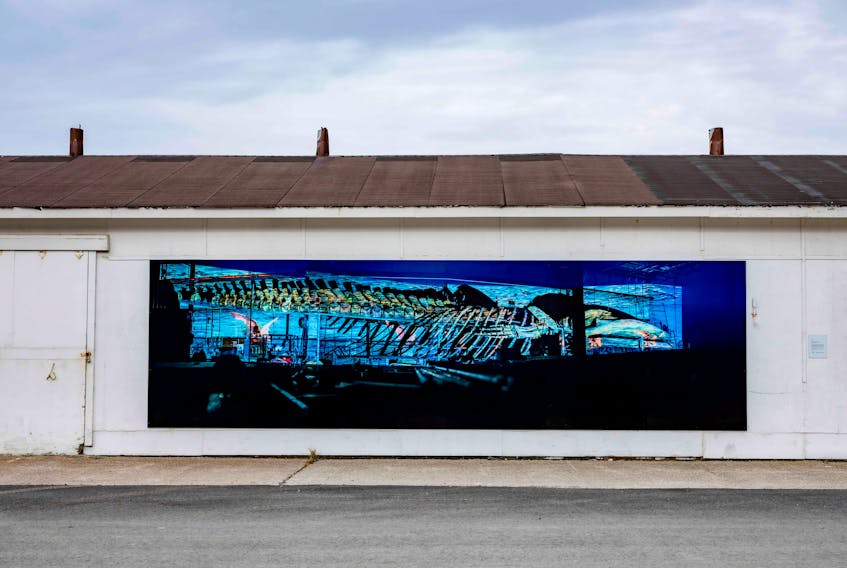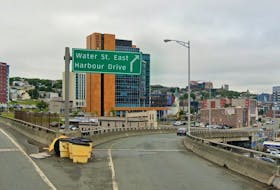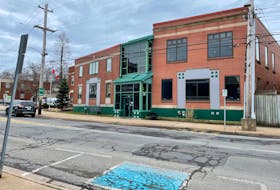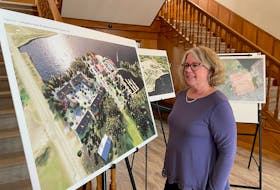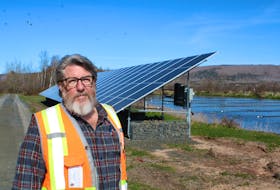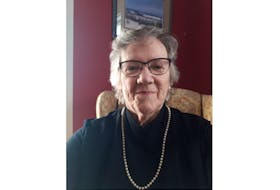A new 24-foot-long artwork commemorates the beaching of the largest mammal on Earth in Trout River in 2014.
“Still Life III (Narratives of Loss)” is a public artwork by Corner Brook-based artist Marc Losier, depicting the skeleton of a blue whale like the one that washed ashore on Trout River’s beach in April 2014.
At the time, the whale, and the predicament its massive carcass presented Trout River, drew international media attention before it was removed by personnel from the Royal Ontario Museum (ROM).
The blue whale’s skeleton is currently displayed at the Research Casting International facility in Trenton, Ont.
The luminous piece, also incorporating local images of whale watching, sea life and the whale, was installed on the side of Trout River’s fish plant, facing the river, on Nov. 23.
In conceptualizing the piece, Losier was interested in the discrepancies between the different perspectives of the whale’s body.
“One of the things I was particularly interested in with the blue whale death in 2014 is the distance between the museum’s presentation of this animal and the actual place from which it was recovered,” he told SaltWire.
Losier explained that when you go to Trout River, other than a small placard, there was very little to commemorate the blue whale’s appearance.
Meanwhile, he found it peculiar how the whale was displayed in a storage facility as if it was on display at a museum.
“For me, it crystallized the different kinds of perspectives that communities have of these animals,” he said. “If you grow up in Ontario, you can only imagine an animal such as the blue whale. But if you grow up in Newfoundland, you have a very different relationship to the ocean and to different kinds of economies and histories that exist on the water. What I wanted to do was to try to animate the whale body in such a way that it reflected aspects of western Newfoundland inside that workspace and create a new kind of depiction of a whale body that hasn’t been seen before.”

The whale ended up in Ontario after the ROM in Toronto was called upon to dissect the whale and bring it back to the museum to be a feature exhibit in 2017.
Losier explains the skeleton on display at the ROM was an “idealized skeleton” comprised of two blue whales and other composite materials.
“It was kind of pulled together or ‘frankensteined,’” he said. “Which is a technique natural history museums use for dinosaurs, for example.”
After the exhibition, the skeleton was moved to the Trenton facility for further analysis.
There, Losier was allowed to photograph the whale for his piece.
Losier lit the skeleton, using digital cinematic projectors, with local images from the Bonne Bay area.
He then took multiple photographs of the skeleton and constructed the art as a composite of these photographs.
Losier said he felt the way the image was constructed reflected the composite reconstruction of the whale for exhibition.
“The process for reconstructing mimics the way in which the museum actually reassembled the whale body for the exhibition,” he said.
Trout River Mayor Horace Crocker called it a “beautiful piece of work” that the community is appreciating more and more.
“As you stop and look at it and think about where it came from, what’s been involved to get it there in the first place, people are starting to accept it,” he told SaltWire Network.
Crocker says the piece is just a couple of hundred feet from where the whale washed ashore.
Losier received permission from the Barry Group, owners of the plant, to install the work on the plant wall.
The piece was initially commissioned to be on display for three months, but Losier says it has been extended until the summer.
Its future afterward is to be determined.
Losier and the Town of Trout River are having discussions about the town acquiring the piece and displaying it at the local fishermen’s museum.
“We don’t want it to leave town, for sure,” said Crocker.
Losier says he is glad the community was receptive to and intrigued by his work.
“You never really know when you’re installing a work in public how the local community is going to receive it,” he said. “So, I’m really grateful it’s been so positive so far.”
The work was commissioned by Creative Gros Morne.
“Still Life III” is part of Losier’s Narratives of Loss series, depicting the skeletal remains of three of the blue whales that died and washed ashore in Gros Morne National Park in 2014.
They were among nine blue whales that were trapped under sea ice in the Gulf of St. Lawrence and drowned earlier that year.
Losier learned of the whales after he moved to Newfoundland in 2016, and calls them victims of climate change.
Stephen Roberts is a reporter covering the west coast of Newfoundland.

